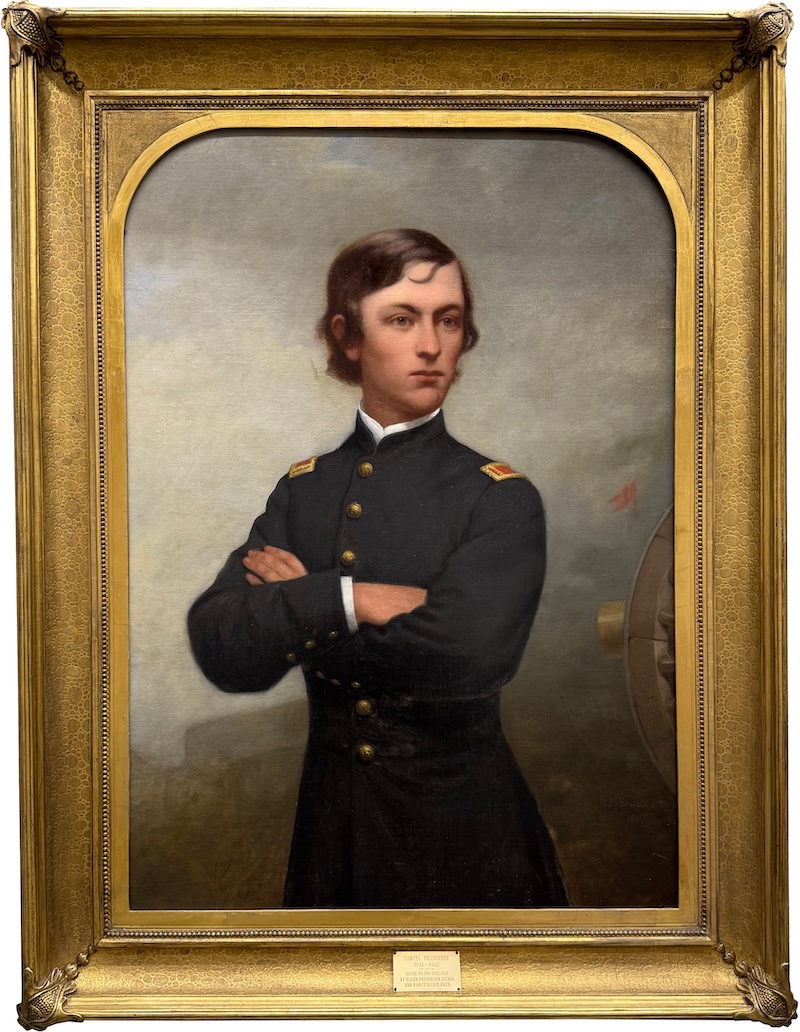Conserving a Civil War-Era Treasure: 'Samuel Fessenden' by Walter M. Brackett
By Bowdoin College Museum of Art
Walter M. Brackett, Portrait of Samuel Fessenden (with frame), 1867, oil on canvas. Bowdoin College Museum, Brunswick, Maine. Gift of Ellen Fessenden Dickie and Nancy Dickie Rath, 1966.102
In last month’s e-Bulletin, Maine State Historian Earle G. Shettleworth, Jr. H’08 highlighted Walter M. Brackett’s posthumous portrait of Lieutenant Samuel Fessenden of the Class of 1861. In 2018 when Shettleworth reviewed the Museum's collection of the nineteenth-century Maine paintings, he was delighted to discover Fessenden's portrait. Its large size, the sitter’s biography and family’s connection to Bowdoin, and the fact that the painting retains its original frame all contribute to its historic significance. Although one of the Museum’s Civil War-era treasures, we soon realized that the painting and its frame needed conservation.
This article celebrates the painting’s recent treatment by Nina A. Roth-Wells, LLC, and the restoration of the frame by Eli Wilner & Company. Roth-Wells ‘91 is a painting conservator based in Georgetown, Maine. Following her Bowdoin graduation, she obtained a graduate degree in art conservation from Queen’s University in Kingston, Ontario. In private practice for over 20 years, she works regularly with the Museum to care for paintings in the collection.
In her initial examination, Roth-Wells found the painting to be in stable condition. Discolored surface coatings, however, obscured its vibrant tones. See the accompanying pre-treatment photograph. The difference in color is visible, especially in the upper left and right corners where the frame’s arched spandrels covered the canvas, thus protecting it from the elements. She also found poorly matched overpainting from an earlier repair. She observed that Brackett used a fine-to-medium weight linen for the canvas and applied paint so smoothly that almost no texture is visible. This evenness enhances the portrait’s overall presence. After conserving the painting, Roth-Wells observed that “Even after treating paintings for thirty years, I’m still surprised by the quality of a painting hidden beneath layers of grime. Samuel Fessenden proved to be a much finer picture than I thought it would be.”
Brackett depended on photographs to create his posthumous portrait and images of the young soldier survive in the Fessenden Collection at Bowdoin’s Special Collections & Archives. Notably, Roth-Wells observed that Brackett’s shading of Samuel’s eyes is similar in style to hand-colored photographs. The picture’s varnish was cleaned, and small areas of loss were inpainted. The transformation is visible in the post-treatment images. Details of the smoke-filled background—the regimental flag and cannon—are visible once again in this now-luminous canvas. The Museum’s Class of 1976 Art Conservation Fund underwrote the painting’s treatment.
Based in New York City, Eli Wilner & Company specializes in the restoration of period frames. Most famously, in 2009, they replicated, based on an 1864 photograph, the lost frame for Emanuel Leutze’s Washington Crossing the Delaware (1851), an iconic American painting in the collection of the Metropolitan Museum of Art. In restoring Fessenden’s original frame, Emma Cotter, Project Director at Eli Wilner, led a team of six conservators to address losses and degraded finishes.
The Fessenden frame does more than house the canvas. A fine nineteenth-century example with oil- and water-based gilding, it enhances the portrait’s presentation. Typical of the mid-nineteenth century, the frame features a wide cove molding with a sand rock pattern, a textured finish, and carved foliate ornaments in the corners. These surfaces are especially vulnerable to deterioration. In the frame’s pre-treatment examination, Cotter noted the significant loss, tarnish, and wear of the decorative finishes. Fortunately, the thin gilt liner along the canvas was intact, and remnants of the foliate ornaments enabled their reproduction.
After the frame’s structural elements were addressed, layers of gesso and clay were applied to the outer frame in preparation for water gilding, and the sand cove was re-gilded. Importantly, the original gilt liner provided a color match for the overall frame. Finally, the frame surface was selectively burnished and rubbed, sealed with shellac, and patinated with ink washes and wax to achieve a period-appropriate character.We are grateful to the Lunder Foundation and Peter and Paula Lunder for generously supporting the frame’s conservation.
In its clean and conserved state, Samuel Fessenden’s portrait not only faithfully honors the fallen Civil War soldier but also contributes to our understanding of American painting in nineteenth-century New England. We look forward to having it on view in the galleries soon.
Laura F. Sprague
Senior Consulting Curator


